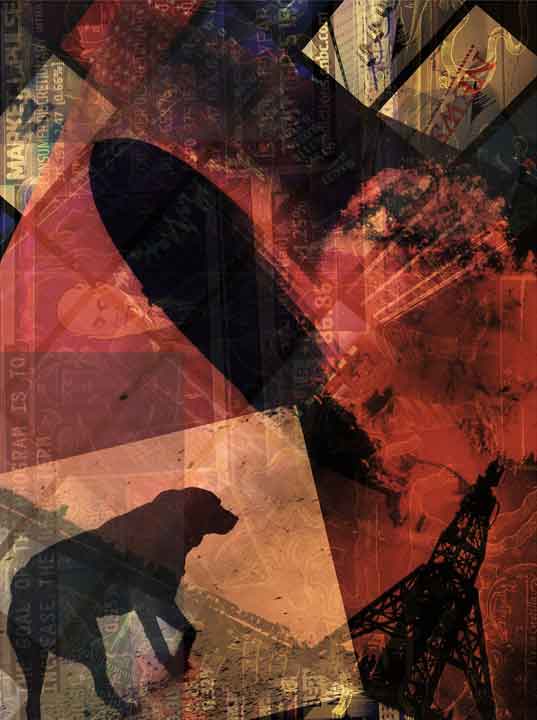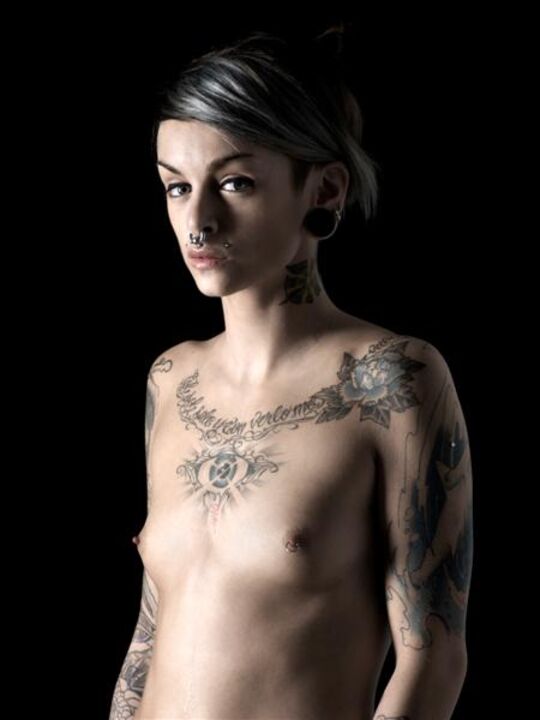Max de Esteban: Of Ghosts and Shells
The perception of an individual artist is, especially if guided by the perspective of art history, often distorted by a form of tragic irony. The more prestige an artist wins through his different works, the more we tend to reduce his Œuvre to one specific aspect of it. Here we can see the rhetorical game of pars pro toto at work. The name of the artist becomes a brand and we declare one specific aspect of his artistic endeavor to be a guiding principle; a red thread to follow; an identity; an essence or fixed perspective we use to understand all of his works and eventually the artist himself. Varying from artist to artist, this single aspect can be a certain technique or style, a certain subject or – this is the most obscene case – one single piece of work. If one dares to mention the extremely prestigious name of Salvador Dalí, the minds of the listeners would instantaneously overflow with pictures of large history paintings full of surreal narratives, crafted in a seemingly Flemish technique. His photographs and ballets are lost to the idea of Dalí.
Finding the Right Angle
This fixed perspective gives us, of course, the feeling of a solid identity and consistency we can throw at the artist’s work while we simulate some kind of understanding. The dialectic of our hermeneutics eventually erases all traces of joyful inconsistency, pleasurable contradiction, and surprise. It is not necessary to explain the reasons and institutional mechanisms of this process here – this has already been done by more talented authors than me. Though it seems unavoidable to write this exposition, if one tries to talk about an Œuvre so varied as the one Max de Esteban offers. At first glance, we see portraits of layered, almost ornamental assemblies of bodies, machines, and text or even rather conventional, strict shots of empty rooms, disrupted by dislocated close-ups of human bones. His work seems to defy the notion of a simple perspective that helps to easily access his art in a literal sense. And yet, here we are, trying to find the right angle.
Max de Esteban: Heads will roll

The Fall
One might call him a photographer, though that would only be half true: The term ‘photography’ is maybe more suited to illustrate what his art is not, rather than what it is. The classic notion of a photographer, who uses his technical eye to show something impossible to see with our biological one is obviously badly suited to understand de Esteban’s tactics. He does not show anything as much as he is slicing, chopping, layering, and assembling clutter of bone and plastic and cable and sinew. His series are called ‘propositions’; maybe a hint that his work should be understood as a conceptual one, rather than a purely sensual experience, because the experience itself serves only to disorient the viewer. One might try to understand the confusing depths of his layers, only to find himself disturbed and repelled by an uncanny lack of space. Even his more conventional photographs are intersected with dislocated bones levitating in an anonymous, white non-space. The viewer cannot position himself in any relation to the picture; he slips, stumbles, and falls.
Vertigo
Because we are floating in de Esteban’s spaceless vertigo anyways, we might as well take some time to meditate on the question of space a little longer. What is its meaning; its function in art as we understand it? It is, obviously, the illusory stage for things to happen. The perspective of the picture tells us where it is happening, and where the viewers place in context of this event is. The renaissance and its discovery of linear perspective played an immense role in defining our idea of ‘correct space’ and how things can happen ‘correctly’. Of course, the technique of perspective is not foreign to non-western cultures, but it was the mathematical pedantry of the renaissance that invented an enclosed visual system where all forms had a specific and seemingly natural order in relation to each other. The logic of foreground, midground and background, as well as the imaginary, yet mathematically constructed lines dictate the order of the painted world. This idea finds itself perfectly elaborated in the writings of the great advocates of linear perspective like Alberti and Dürer: The vision of an artificial window into the world; a visual system that could impeccably expand beyond the frame.
An Order for Things
One might argue that this type of painting is simply nothing more than an accurate mímesis of natural sight, though he would be mistaken. Everyday language is enough to unmask this illusion. Foreground, midground and background bear obvious semantic meaning. If we say we want to ‘put something into perspective’, we argue that we have to organize and rationalize an idea, a thought in relation to a system of ideas and thoughts. Perspective is not a natural order, but an order that is defined through narration and convention. There are those who find joy in laughing about medieval composition. It seems far too unnatural and ridiculous to them, though they miss that the mathematics of linear perspective are a mask hiding the same amount of symbolism. Linear perspective is the vulgar confusion of style with nature. The center of this style is, of course, the viewer himself, whose gaze endlessly conquers an ever-expanding pictorial world organized akin to that gaze. A form unfitting in this order is deemed incorrect. This kind of picture is obviously perfectly suited to provoke narcissistic fantasies; subjectivity is driven to an absolute and eventually conquering the empty throne of objectivity. But as I mentioned before, perspective also ensures security: we know who we are, where we are, and our relation to the events shown in the picture. As much as we rule this pictorial world, this pictorial world rules us by setting us in our place.
A Return to Space?
Our trip through the vertigo has become a journey through time. This kind of perspective seems long gone. The Cubists have reinvented space by endlessly multiplying it; abstract painting has long deserted illusory space. But de Esteban is not a painter, and neither a photographer. Photography is enviously holding onto the paradigm of the real. Even though we ensure ourselves that we are completely aware of the possibilities of photographic manipulation, this acknowledgment is little more than a weak revolt of the intellect. After all, the digital revolution ensures an overwhelming omnipresence of photographs we use deliberately as windows to the world. Dürer is no longer needed to meticulously construct an illusion of naturality, everyone can create it within a blink of the digital eye. Our excitement of photography is our hope of the return of the natural, of the real, feeding off the same aesthetics like those paintings we have learned to distrust.
A Lens for an Eye
De Esteban’s accomplishment is not simply to challenge our idea of reality in photography – this is an ongoing project by fine art photography in general – but it is to question why we even trust photography in the first place. I have mentioned the return of convention and the idea of the natural as reasons, but there is certainly more to it. Critical reflection has taught us that it may be wise to distrust our human perception when it comes to reality. But a camera is no human, and a lens is no eye. We draw a very sharp line between the technical and the human, which sets them as polar opposites. The 19th century discourse of photography was fueled by this logic. Photography was not seen as art due to its technical nature; it was something different, something of the realm of mechanical otherness. As soon as man accepted the fallibility of his beloved scientific methods, he projected his hopes onto his technological children. They were responsible to create what the human could not: a guarantee for a solid reality. Blurring the line between flesh and machine might dissolve those hopes.
Flesh and Plastic
And this is exactly what de Esteban does. Body and machine are layered and intersected in his incomprehensible space which leaves us without clear orientation. His empty classrooms show us the assembly lines for humans – the bones are raw material. We see traces of bodies, reproduced multiple times in the rhythm of the industrial music of the printing press. One could intuitively construct a space to organize a distinction between the human and the non-human, but the lack of it is repulsing and uncanny. Grinding gears and joints, metal and bone, cable and sinew are cluttered together. We slowly become aware of the contradictions our idea of the body is based on. At once sacrilegious and sacred is a rather fitting title. It offers something like an x-ray vision into the layers of a mechanical body consisting of circuit boards, plastic casing, and those beloved digital menu buttons we like to caress daily. But there, in the lower right corner, we find forms strangely reminding us of eyes and ensuring to us a magical animus residing in this shell of plastic. De Esteban’s proposition Only the Ephemeral shows us the sliced-up carcasses of old machines which became useless. It is a Körperwelten for the technical; surprisingly fragile and intimate, with an almost translucent feel to the broken bodies. De Esteban conjured the spirit of those machines to haunt us in a present where we have forgotten them. They answered his call.
The Fear of the Automaton
A camera is no human, and a lens is no eye – a useless notion in de Esteban’s work. Of course, this has to produce unease. One of the great anxieties of the industrial man was, after all, the idea of the false, artificial human, the automaton or cyborg – creatures reduced to scientific positivism, indistinguishable by the mere eye, and yet, completely foreign. Authors like E.T.A. Hoffmann tell us of those fears. Men had to be something more than a mere machine made of flesh, like the perverted creations of Dr. Moreau. There had to be something mystical that transcends the limits of birth and death which neatly define the borders of our life. It was necessary for the idea of the autonomous subject. But de Esteban shows us that even this idea is a style, not a substance, and freely gives the soul to the automaton, while shattering the subject into pieces. Is it not ironic that we create technology, like photography, which has to perfectly imitate and surpass what we perceive as natural human sight? Maybe we ourselves are machines imitating humans, creating machines which imitate humans to produce an ideal of nature by the most ‘unnatural’ means possible. Are we only producing machines and pictures, or are those machines and pictures at the same time producing us? The naive fears of the past must concern us, as does anything in history. And yet, the industrial man is gone; his flesh has been washed away by the waning surges of technological advancement to reveal plastic and steel. Omnipresent digital technology embraces our bodies to an extent that it becomes ridiculous to differentiate between ourselves and the machine. Bodies need space, but the virtual does not. Every little pocket contains a device which endlessly extends who we are, how and what we think, and how we perceive the world. Alas, it is true! It would be foolish to imagine ourselves as anything but cyborgs.
Max de Esteban: Elegies of Manumission

Cyborgs
De Esteban’s work revolves around, as so often in art, questions of the body: its limits and borders and its imagined purity as an opposite to technology; the idea of the self-legitimizing natural versus the artificial that must be considered a mere style. This unsolved contradiction is the driving force of de Esteban’s portrait series, which at first glance puts the body in front of the viewer. Those are quite particular bodies as well, as they hold the signs of subcultural belonging. Augmentations are everywhere: coloured hair, piercings, implants, and tattoos. The interesting thing about the subcultural body is that it defies our notion of the natural body. It does so by pronouncing style and fashion, which are often imagined as an opposite to a natural, true self, that might be clothed by social and technological contexts but ultimately transcends them. The naked truth, as it is shown by an artist like Klimt, appears as a nude, pale girl with white flowers sprouting from her fiery head. She obviously belongs to an idea of nature. But the Bodies of de Esteban do not; they are assembled, their frames stabilized by fragile chiffre. One might try to ‘free’ them, as the title suggests, stripping them naked, removing everything ephemeral. But the augmentations persist. One could try to remove those also by ripping out piercings, died hair, slicing off tattoos in the search of the natural, true man. But if we do so, how long does it take before we eventually create portraits which, ironically, cannot represent anyone at all? How long does it take before we reduce those bodies to the flesh-machine we so desperately wanted to escape? There probably is no solid substance to be found that serves as the base for the dividing line against the artificial. It seems that being human is rather a matter of assembled style than of nature, or truth, or any other single aspect we try to set into perspective.
Contact
Klompching Gallery
89 Water Street
Brooklyn, NY 11201
United States of America
info@klompching.com
www.klompching.com
Author

Kende Bors, born in 1994, Marosvásárhely
Has a B.A. in art history and german literature. Studies literature mediation.
Internship: Summer 2022
Special Interests: Art and literature of the Décadence and cultural theory.








